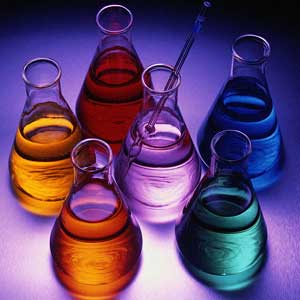1. Atom – the smallest unit of an element that displays the same properties as the element, for example, hydrogen.
2. Atomic number – The number of protons in the nucleus of an atom; for example, the atomic number for helium is 2.
3. Chemical formula – A short form used to represent a molecule; uses letters and numbers; only pure substances have chemical formulas; H2O is the chemical formula for water.
4. Chemical property – The ability of a substance to change or react and to form new substances when interacting with other substances, for example, zinc reacts with hydrochloric acid to produce hydrogen gas.
5. Chemical reaction – Any change that occurs when substances interact to produce new substances with new properties; changes in the chemical and physical properties of the pure substances let you know that a chemical reaction has occurred; when vinegar and baking soda are combined, they react to produce frothy bubbles.
6. Chemical symbol – A short form used to represent the name of an element; C is the chemical symbol for carbon.
7. Combustibility – The ability of a substance to catch fire and burn in air.
8. Compound – A pure substance that can be broken down into smaller parts using chemical properties; water and carbon dioxide are both examples of compounds; all parts of a compound will contain identical molecules; in distilled water, all parts will contain identical H2O molecules.
9. Conductivity – Describes how easily a substance lets heat or electricity move through it.
10. Decomposition – A kind of reactivity that can break down a substance into its parts; for example, water can be broken down into hydrogen and oxygen by decomposition.
11. Density – Describes how compact a substance is, and is calculated by dividing mass by volume or D = m/v.
12. Electron – A particle of an atom that surrounds the nucleus; has a charge of negative one.
13. Element – A pure substance that cannot be broken down into simpler parts by chemical methods; all the elements are listed on the Periodic Table; all of the particles in an element are identical, as shown in the element aluminum.
14. Family – A vertical column of elements in the periodic table also known as a group.
15. Luster – The ability to reflect light, or shine; silver has a high luster and is so popular for jewelry; sodium metal is also lustrous.
16. Matter – Anything that has mass and occupies space (volume).
17. Metal – Typically, an element that is solid at room temperature, shiny, malleable, ductile, and a good conductor; for example, aluminum, iron, and calcium.
18. Mixture – matter than can be separated into parts using differences in physical properties; saltwater is a mixture of salt and water.
19. Molecule – A type of particle that is made up of two or more atoms bonded together; carbon monoxide is an example of a molecule.
20. Neutron – Located in the nucleus of an atom, has no charge.
21. Nucleus – In chemistry, the charged center of an atom; contains the atoms protons and neutrons.
22. Period – A horizontal row of elements in the periodic table; for example, sodium, magnesium, aluminum, silicon, phosphorus, sulfur, chlorine, and argon make up period 3 of the periodic table.
23. Periodic Table – A system for organizing the elements into columns and rows, so that elements with similar properties are in the same column.
24. Physical property – The way matter looks, feels, smells or tastes; one physical property of gold is its lustre.
25. Precipitation – A solid substance that can form when certain dissolved substances are mixed together.
26. Proton – A particle of an atom that is inside the nucleus; has a positive charge.
27. Pure substance – A substance made up of only one kind of matter; for instance, copper, distilled water and aluminum are all pure substances.
28. Solubility – Describes how much of a substance dissolves in another substance.
29. Texture – Describes how the surface of a substance feels (its roughness, softness, or smoothness).

